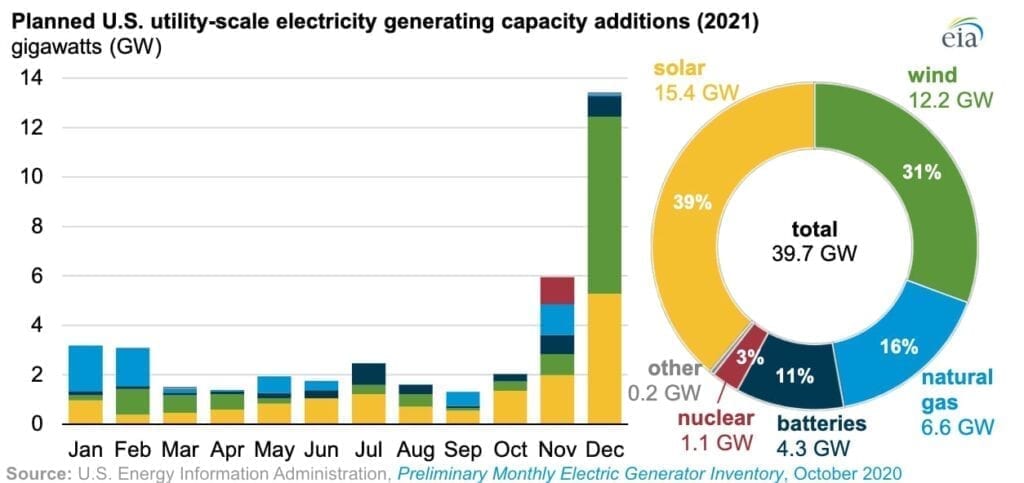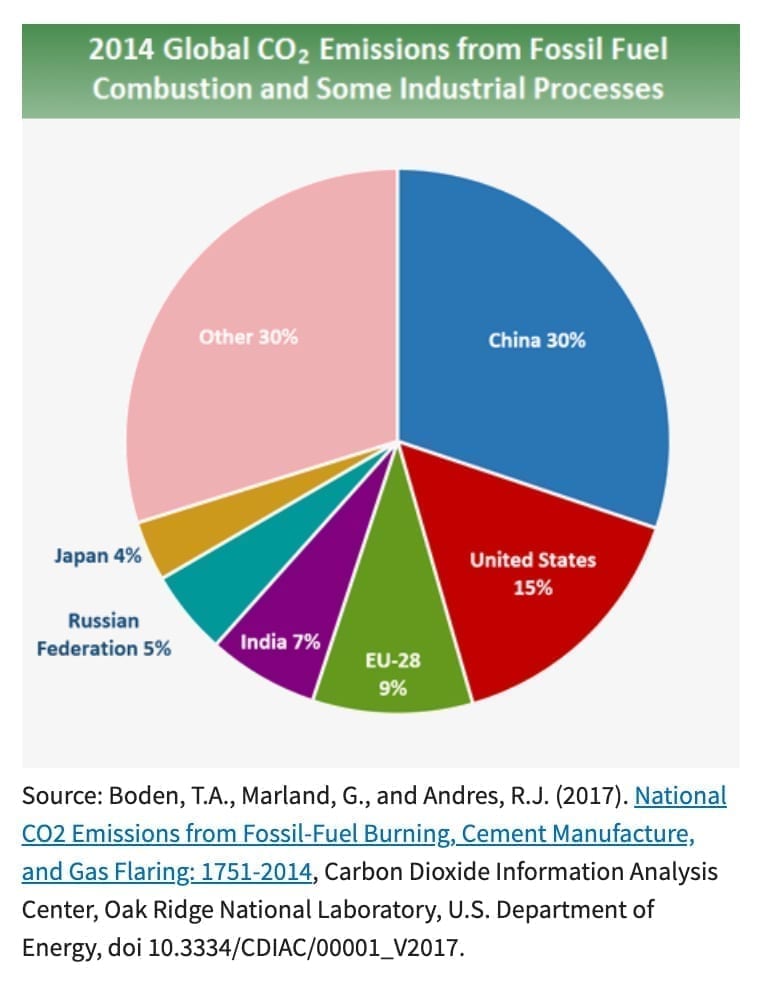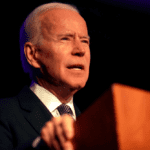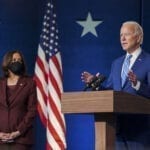National Climate Advisor Gina McCarthy and Special Presidential Envoy for Climate John Kerry during a wide-ranging press briefing on Jan. 27 detailed the Biden administration’s next steps to embed climate policy into foreign policy and national security initiatives.
Climate action, envisioned for a quick rollout, may entail new clean energy targets at home and abroad.
A ‘Carbon Pollution–Free’ Power Sector by 2035
The White House held the press briefing with McCarthy and Kerry on Wednesday—“Climate Day”—as President Biden signed a new executive action directing the newly established National Climate Task Force to use federal procurement authority to “achieve or facilitate” a “carbon pollution–free electricity sector” by 2035, and “clean and zero-emission vehicles” for federal, state, local, and tribal government fleets.
The targets are part of a larger “comprehensive plan” that will be put together by the chair of the Council on Environmental Quality, the administrator of General Services, and the Director of the Office and Management and Budget in coordination with the Secretaries of Energy, Labor, and Commerce. These entities will submit the plan to the national task force within three months. As described, the plan will likely be wholly dependent on “revitalizing” the federal government’s “sustainability efforts.” Significantly, however, the plan could recommend “any additional legislation needed to accomplish these objectives.”
Biden on Wednesday said “transforming the American electric sector to produce power without carbon pollution will be a tremendous spur of job creation and economic competitiveness in the 21st century, not to mention the benefits to our health and to our environment.” The nation has already made the pivot, he suggested, claiming, “Already 84% of all new electric capacity planned to come onto the electric grid this year is clean energy.”

A Target to Double Offshore Wind
Biden’s “Executive Order on Tackling the Climate Crisis at Home and Abroad,” notably also directs the Secretary of the Interior to increase renewable energy production on federal lands, and sets a specific goal of doubling offshore wind by 2030.
So far, though Interior’s Bureau of Ocean Energy Management (BOEM) has issued 15 active commercial wind energy leases, and the Department of Energy suggests the U.S. could develop a total 86 GW of offshore wind projects by 2050, only two turbines at Dominion’s 12-MW Coastal Virginia Offshore Wind (CVOW) pilot project are operational on federal waters off the the coast of Virginia Beach. Dominion in December filed a construction and operations plan (COP) with BOEM to build a 2.6-GW commercial project in an adjacent commercial lease area offshore Virginia, but company documents show Dominion expects BOEM’s review—which is required before turbine installation can begin—could take up to two years. Dominion expects construction will begin in 2024 and be completed in 2026.
On Monday, Vineyard Wind, developer of an 800-MW offshore wind project off the coast of Martha’s Vineyard in Massachusetts, rescinded its request to withdraw its COP, allowing federal permitting to resume. If Vineyard puts the project online by 2023 as planned, it will become the first large-scale commercial offshore wind farm in the U.S.
McCarthy: Industry Is Bolstering National Ambitions
During the briefing, McCarthy, who served as President Obama’s administrator of the U.S. Environmental Protection Agency (EPA), suggested collaboration will be essential to meet aggressive goals set by Biden’s newly established White House Office of Domestic Climate Policy. Biden’s climate executive order “directs everyone who works for the president to use every tool available at our disposal to solve the climate crisis, because we’re going to take a whole of government approach. We’re going to power our economy with clean energy,” she said.
However, McCarthy also noted private sector contributions will drive the nation’s climate ambitions. “We are talking about solutions that we’re not asking anybody to sacrifice, but add to their advantage. And if you look at the record over the past four years, while the prior administration might’ve wanted clean energy to head in a different direction, it’s gone faster and farther than anyone ever expected,” she said.
The administration’s actions will serve as renewed “signals to the marketplace who are purchasing at the federal level and are re-looking at different ways of having on the ground change. We can build that demand. We can actually grow significantly millions of clean energy jobs,” she said. “And all of a sudden the question won’t be whether the private sector’s going to buy into it, the private sector’s going to drive it. And so this is going to be a signal setter, the way the federal government ought to set on what our values are, what we think the future needs to be.”
No New International Climate Targets—Yet
Kerry, who served as Obama’s Secretary of State and now holds the post as the nation’s first ever International Climate Envoy, described a more formidable task to integrate climate initiatives into foreign policy. “We have a big agenda in front of us on a global basis,” he said.
So far, while Biden has acted to rejoin the Paris Climate Agreement, “He also knows that Paris alone is not enough, not when almost 90% of all of the planet’s global emissions come from outside of U.S. borders,” Kerry said.
Wednesday’s executive order “sets forth a process for us to develop an ambitious new Paris target, as well as a U.S. climate finance plan, both of which are essential to our being able to bring countries of the world together to raise ambition and meet this moment when we go to Glasgow for the follow-on agreement to Paris,” he said.
However, the U.S. nationally determined contribution (NDC)—a long-term goal that embodies efforts by each country to reduce national emissions—has yet to be determined. As it stands, the Obama administration’s goals set under the Paris accord seek an economy-wide greenhouse gas emissions reduction of 26% to 28% below 2005 levels by 2025. McCarthy said the Biden administration is looking to announce an NDC before a global leader’s climate change summit planned for Earth Day on April 22.
McCarthy noted the administration is “going to be out of the gate working with the agencies to see what kind of reductions and mitigation opportunities there are. And also again, to look at our public lands, to make sure that we can continue to store carbon in our soil, to work with agriculture and others, to look at how we better manage our forest so we’re not seeing the devastating forest fires that we’ve been having before,” she said.
“So all across the federal government, every agency, and you’ll see many of them specifically tasked in this executive order, will participate in the task force that we’re going to have to actually develop the most aggressive NDC that we can to deliver the kind of boost that Secretary Kerry is looking for to be able to ensure that our international efforts are robust and sufficient to address the challenge internationally,” she said.
Kerry affirmed that domestic efforts will be crucial to U.S. leadership. “What Gina succeeds in pulling together is essential to our ability to have credibility in the world,” he said. U.S. greenhouse gas emissions currently stand at about 15% of global emissions, while China makes up 30%, he said.
(POWER has asked for a source for these claims. The EPA’s current global greenhouse gas emissions data web page reflects those numbers, but that data describes 2014 emissions from a source published in 2017.)

According to the European Commission’s Joint Research Centre’s Emissions Database for Global Atmospheric Research (EDGAR), China, the U.S., India, the European Union (EU, including the UK), Russia, and Japan emitted 67% of total global fossil carbon dioxide in 2019. China emitted 30% of global carbon dioxide from fossil fuels, while the U.S. share was 13%. The EU’s share was 9%, followed by India (7%), Russia (5%), and Japan (3%).
The EDGAR data suggests that in 2019, China’s power industry produced 34%—the bulk—of the world’s fossil-fired carbon dioxide emissions. The U.S. power industry followed at 12%, then India (9%), Russia (6%), Japan (4%). Lagging behind these countries were South Korea, Indonesia, South Africa, Saudi Arabia, and Germany, which each produced 2%.
Beyond the Paris accord, the Biden administration’s State Department is readying to prepare a transmittal package seeking Senate advice and consent on the 2016 Kigali Amendment to the Montreal Protocol to phase down hydrofluorocarbons, Kerry said. It’s an “amendment that by itself, if ratified and fully enforced globally, could hold the Earth’s temperature by 0.5 of an entire degree—not insignificant,” Kerry said.
—Sonal Patel is a POWER senior associate editor (@sonalcpatel, @POWERmagazine).
Updated (Jan. 29): Adds a graphic sourced from the EPA’s current page on global GHG emissions: https://www.epa.gov/ghgemissions/global-greenhouse-gas-emissions-data#Country. and more details gleaned from European Commission’s EDGAR data, which provides data for 2019. The EPA data, which matches Kerry’s assertions on Jan. 27, describe 2014 global emissions from a 2017 report. It is unclear if Kerry was referencing this data or another more current official dataset.










